Jordan 2022
Jordan – 3rd to 16th November 2022
We have decided with George to spend this year holiday in Jordan, a country in which none of us has been before.
First some introductory information. Jordan has approximately the same area and the same number of population as the Czech Republic, but there all similarities end.
The official name of the country is Hashemite Kingdom of Jordan. The adjective „hashemite“ means direct descendant of Hashim, the great grandfather of the Islamic prophet Muhammad, meaning that the state claims to be in direct line connected with prophet Muhammad. The name Jordan is taken from Jordan river which forms much of the northwestern border of the country which was originally called Transjordan.
Geografical position of Jordan could not be more complicated. It is bordered by Saudi Arabia to the south and east, Iraq to the northeast, Syria to the north and the Palestinian West Bank, Israel (and the Dead Sea) to the West – all countries with little stability and some of them torn by repeated wars and unrest (Iraq, Syria and Israel.) Jordan has only 26 kilometers of the Red Sea (the Gulf and port of Aqaba) which separates it from Egypt.
Religion: 93 % of population belong to Sunni Islam, there is a small number of Ahmadi Muslims (Islamic revival messianic movement founded at the end of 19th century in Panjab, British India, now around 20 million worldwide – they have been abolished in Pakistan in 1974 and are not recognized as Muslims, in some countries they are persecuted) and some Shiites (mostly Iraqi and Lebanese refugees.) Muslims who convert to another religion as well as missionaries from other religions face social and legal discrimination, but generally all people we met seemed to be very tolerant to the members of other religious communities.
Our journey
Day 1 – Gerasa (Jarash or Jerash)
This was my third visit of Roman excavations this year – first Pompei with Lucy and Petra, second Volubilis in Morocco, and now Gerasa. It had its golden era under the Greeks and then the Romans when it was one of the ten Helenistic cities known as the Decapolis League of semi-autonomous cities, even mentioned in the Bible. It earned the nickname of Pompeii of the Middle East because of the extent of excavations and preservation. 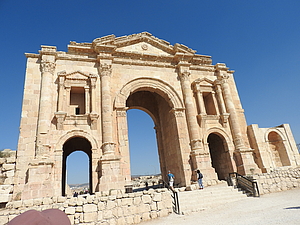
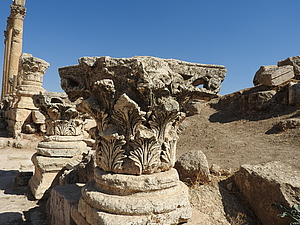
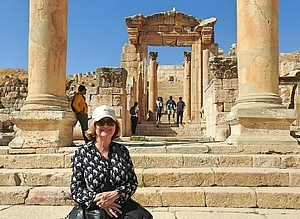
Day 2 – capital of Jordan - Amman
First we visited the Citadel, which meant my fourth visit of the Roman excavations this year J. I am becoming an expert. The most significant Roman structure in the Citadel is Hercules temple (who seems to be the most popular hero also in Gibraltar and Morocco). The site also contains fragments of his colossal stone statue, estimated to have been over 12 m tall. It was probably destroyed in an earthquake. All that remains are three fingers and an elbow.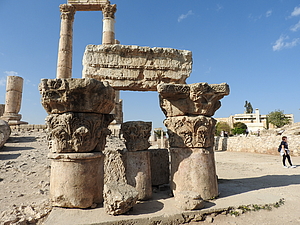
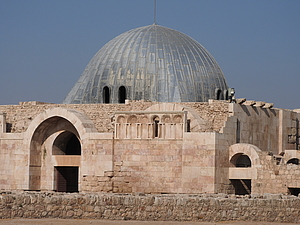
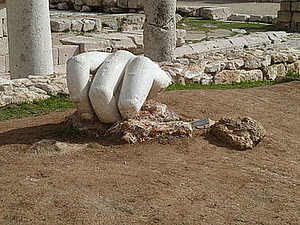
The morning continued with a walk through fruit and vegetables market (in Arabic - souk), full of shapes, colours and haggling customers.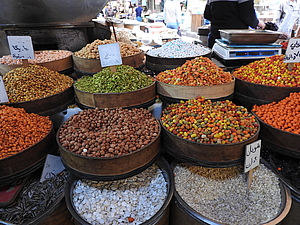
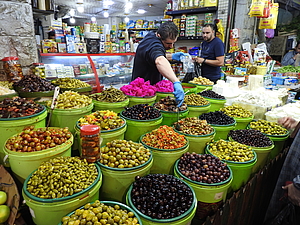
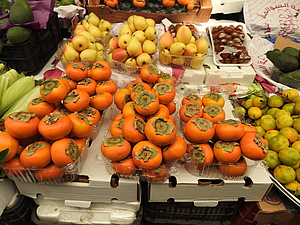
Day 3 – Amman and Madaba
We have visited a mosque of the King Abdulah I. visible from afar for its blue dome and minaret. It is octagonal and distinguished for not having any pillars inside, it has capacity for 3000 worshipers. As usual we had to take shoes off, females had to put on a special long gown. But at least in case of this mosque non Muslims are allowed to enter (with the exception of Fridays.) Very fine pleasantly thick carpet to walk on, big space for prayers, not much decoration. 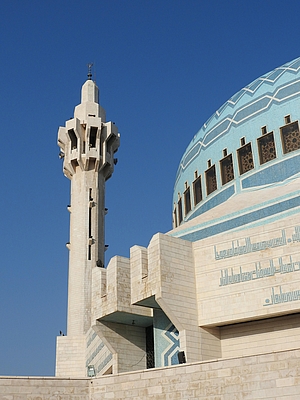
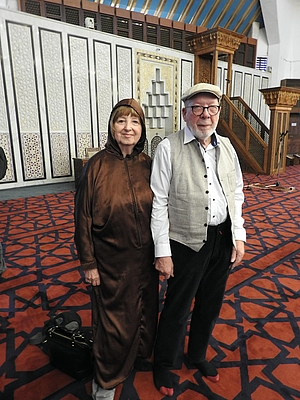
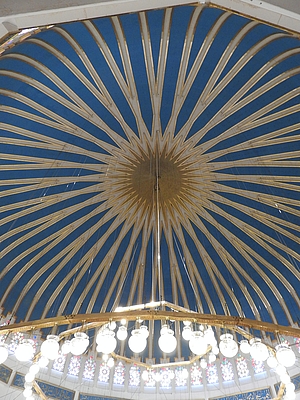
We continued to Madaba, the city of mosaics. We were walking in the streets, passing interesting shops, couple of mosques until we reached the Greek orthodox St. George´s Church with the famous floor mosaic of Madaba map. It depicts part of the Middle East and it is the oldest surviving original cartographic depiction of the Holy Land and Jerusalem from the 6th century.
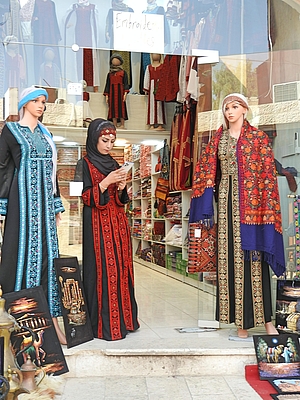
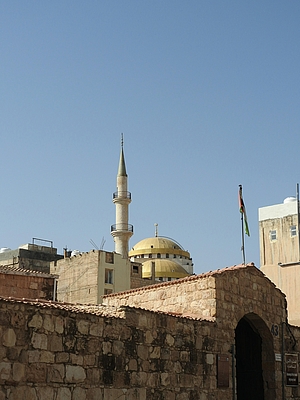
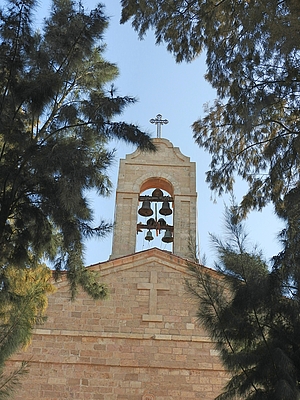
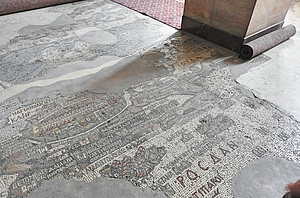
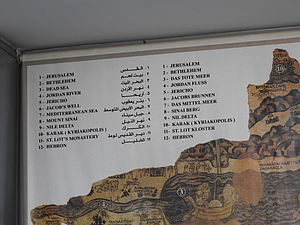
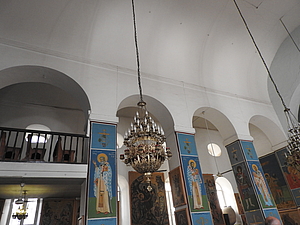
Madaba has been famous for its mosaics from the old days until now. We were invited to a Center of Mosaics where some very patient youngsters were putting miniature pieces of stones into various designs and pictures. 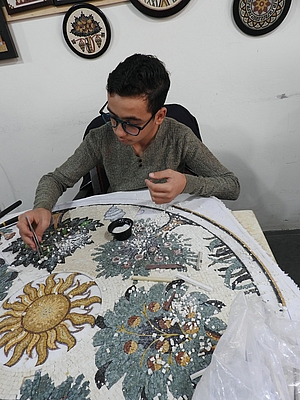
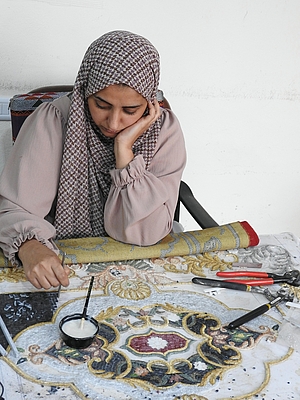
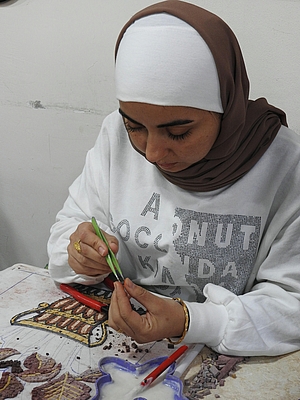
Further on we climbed to Mount Nebo, a place from where the Moses is supposed to have seen the Promised Land to which he led his people from Egypt and which he never entered. The Serpentine Cross is a symbolic of a serpent which Moses took with him to desert and the cross upon which Jesus was crucified. The Abu Bad is a rolling stone used as a fortified door of the Byzantine monastery in the old village of Faisalyah, once known as Abu Dab.The statue near to it is dedicated to Pope Paul II who visited Mount Nebo in 2000.
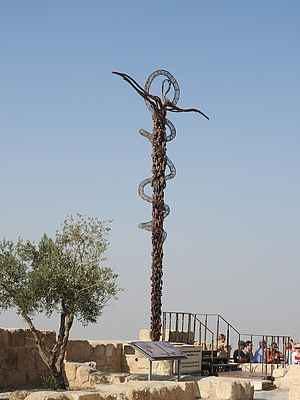
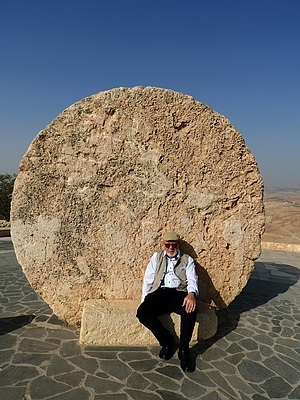
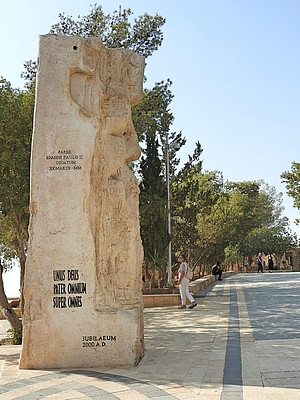
We also admired a well preserved mosaic on the floor in the Diakonikon Baptistry of the Moses Memorial Church which depicts a hunting and herding scenes with various animals. It originates from the 6th century AD.We were lucky that we had quite a clear view to the landscape up to the Israel border. 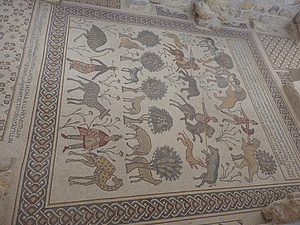
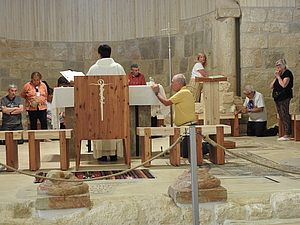
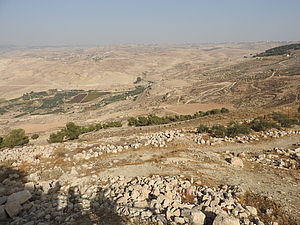
In the afternoon we reached the Dead Sea. The Dead Sea a salt lake bordered by Jordan to the east and Israel and the West Bank to the West. Its main tributary is Jordan River (I immediately remembered the song sung in the sixties by Helena Vondráčková, Cross the Jordan). The lake's surface is approximately 430 metres below sea level, making its shores the lowest land-based place in the world. It is nearly 10 times as salty as the ocean. We were floating in its waters for recommended 15 minutes. It is impossible to swim breaststroke there, the only possibility is the backstroke, but mostly it is really only floating. The Dead Sea has attracted visitors for thousands of years. It was one of the world's first health resorts (for Herod the Great) and it has been the supplier of a wide variety of products, from asphalt for Egyptian mummification to potash for fertilisers. According my point of view, the Dead Sea was not the most impressive experience, much more impressive were the landscapes with macabre formations and curvy roads on the way to the Dead Sea. 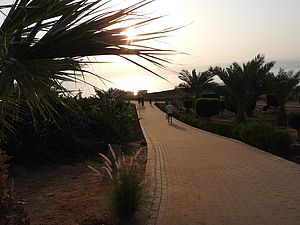
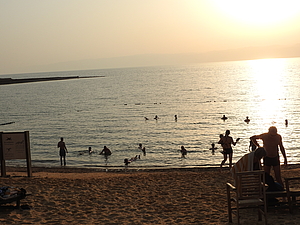
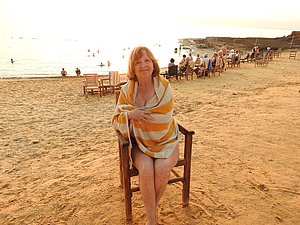
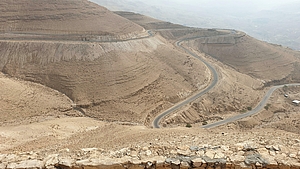

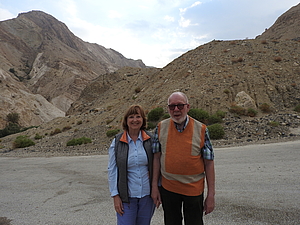
Day 4 – Crusaders Castle Kerak
On the way to Kerak (or Karak) we could see the similar strange rock formations on the serpentine roads as the day before. We made stops for refreshments at most deserted places. We sipped peppermint tea on the cliff of the house whose owner was living alone, cooked for occasional guests and rented two rooms. He wanted to convince me to stay on the cliff with a beautiful view with him, but I was not convinced 
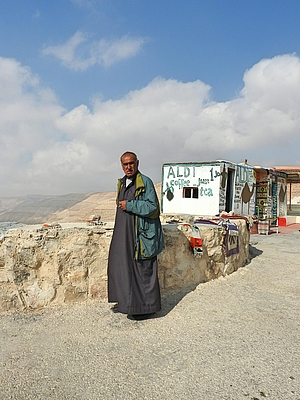
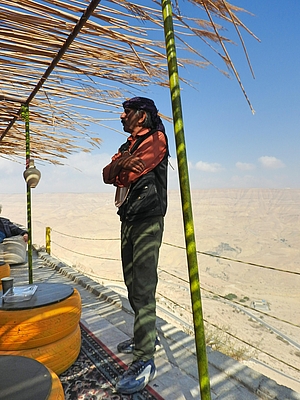
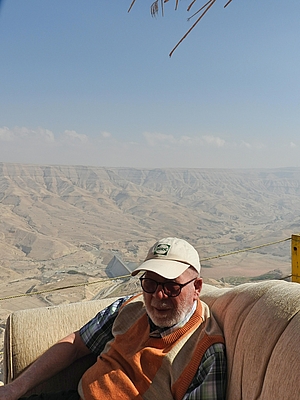
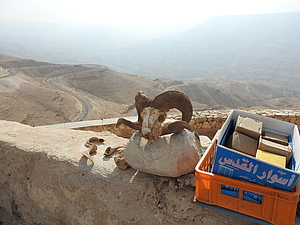
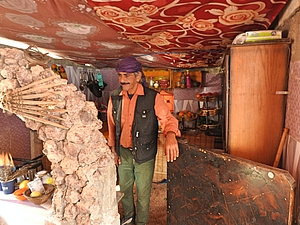
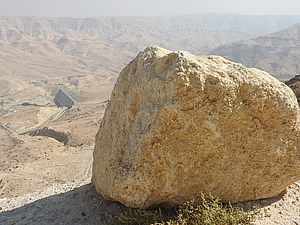
The castle Kerak itself originated in the 12th century and was a crusader stronghold, later Mamluk fortress (Mamluks, also spelled Mamelukes, were members of one of the armies of slaves established during the Abbasid era that later won political control of several Muslim states. Under the Ayyubid sultanate, Mamluk generals used their power to establish a dynasty that ruled Egypt and Syria from 1250 to 1517). From the top of the stairs there was a good view of Wadi Karak and also of the place where the condemned cities Sodom and Gomorrah were supposed to be situated. Karak Castle was targeted by terrorists in 2016.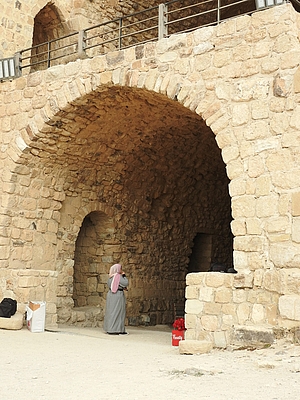
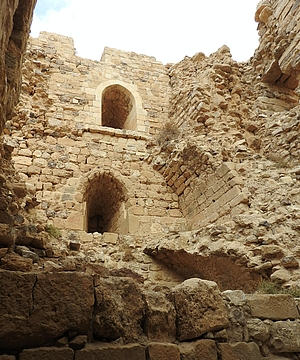
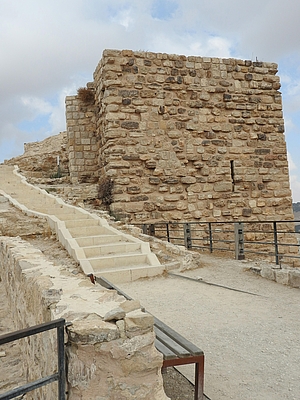
Day 5 - Petra
The Nabatean Arabs, one of the most gifted peoples of the ancient World are today known only for their beautiful rock-carved capital Petra. Beginning as pastoral nomads they became wealthy traders in incense and spices. Their skills in managing the meagre water resources enabled them, when trade declined, to develop agriculture. It is unbelievable that these former tent-dwellers could create such a sublime and individual form of architecture. Traces of Nabatean creativity appear not only in Petra, but also among the wild rock formations in Wadi Rum, along trade and pilgrimage routes in Sinai and in towns and temples throughout Jordan into Syria. They exploited the struggle for power between the two Greek powers, the Ptolemies based in Egypt and Sleucids based in Syria and established an independent kingdom in 169 BC. The Nabataean Kingdom controlled much of the trade routes of the region, stretching south along the Red Sea and Hejaz desert up to Damascus, flourishing between the 4th century BCE to 106 CE. The Nabatean flame was snuffed out by the Romans and later also by two earthquakes. Their elaborate structures in Petra including Al-Khazneh (the Treasure), which is believed to be the mausoleum of the Nabataen King Aretas V, were rediscovered by Swiss explorer Johann Ludwig Burckhardt in 1812. 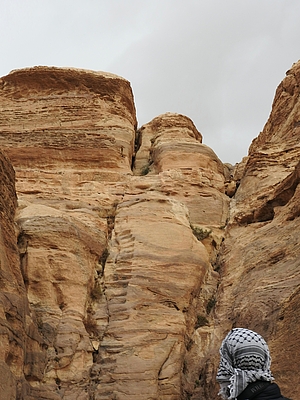
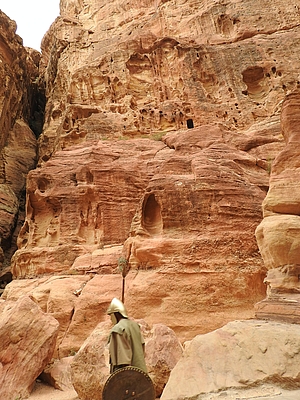
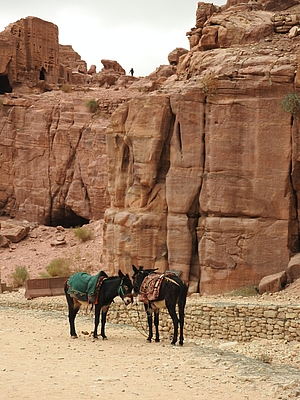
We used small electro cars from the Museum of Petra to the heart of excavations and back and then we walked 8 kilometers around. It is a huge area where it would be possible to walk for days. As it is the main historical monument of Jordan, there were more tourists there than we expected in the month of November.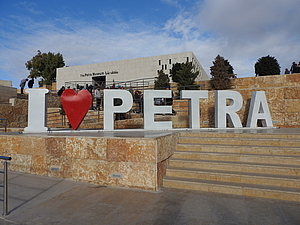
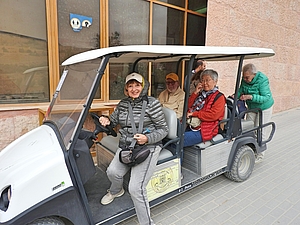
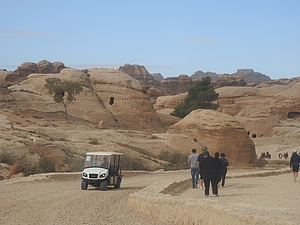
We mounted camels for a photo in front of the Al-Khazneh (10 dinars for each person after haggling, 1 Jordanian Dinar is cca 1,4 EUR). The photos were taken by the camel caretaker. When we dismounted we found out that all photos were blurred and could not be used at all. We wrote the money off, and said to ourselves, that we had liked the experience and that was more important than photos. However, when another camel carer asked again if we wanted to have a photo on the camel, we told him that we already did it but that was money thrown out of the window, because the photos were good for nothing. The guy who took the photo said that it was fault of our camera, but I took a perfectly sharp photo of him to prove, that he was wrong. To our big surprise, the second camel owner said that the photo session on camels had to be repeated FREE OF CHARGE, that that was a question of honor and reprimanded his „brother.“ So we repeated the exercise – mounting the camel, taking photos, checking photos, dismounting the camel. After that achievement my legs were trembling so that I badly needed a cup of coffee. 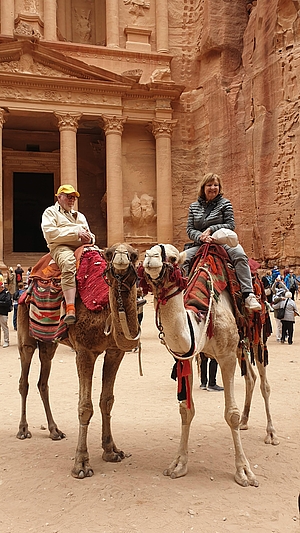
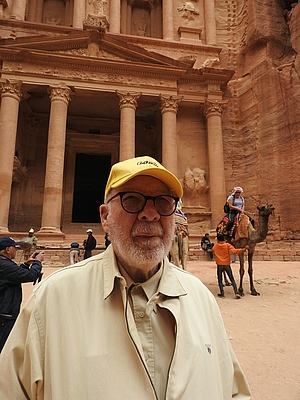
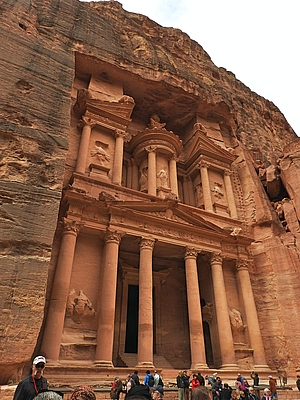
There were some small cafes and restaurants and stalls at the area of Petra. In one of them, handsome Bedouin Amir was offering black eye make-up called kohl. The recipe for making it varies by region, but in Jordan it is used by both women and some men to prevent sand from getting into their eyes in the desert, as a protection against solar radiation, and according to legend, it also protects the wearer from evil eye which is why some mothers use it for their children. Of course, Amir was also selling kohl in miniature brass tins, so I couldn't resist and bought two for my daughters.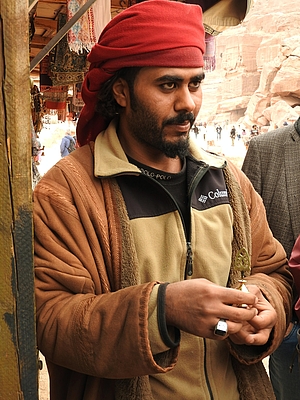
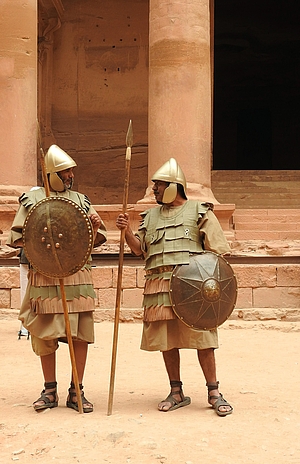
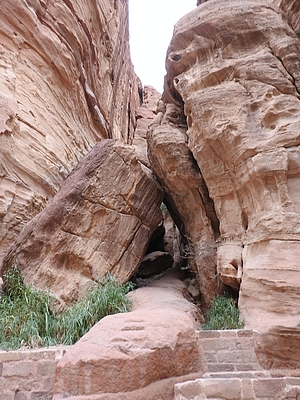
Day 6 – excursion Wadi Arab desert
We went to the desert by three Toyota jeeps, 3 tourists in each of them. We went in the last one. On the way to the dunes, the drivers collected pieces of shrubs for making a fire to prepare tea for us. The first jeep made it up the huge dune but the remaining ones did not succeed. A few attempts were made without success, so that we had to get off in the middle of the dune and climb. After that the remaining jeeps were less heavy and drivers were probably not afraid to take bigger risk without passengers and they both made it eventually to the top. But it was quite an adventure to be repeatedly stuck in the sand. 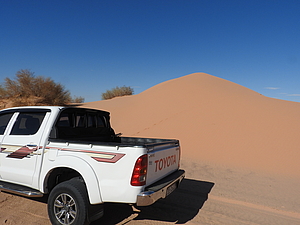
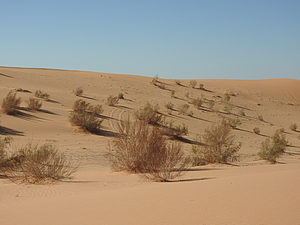
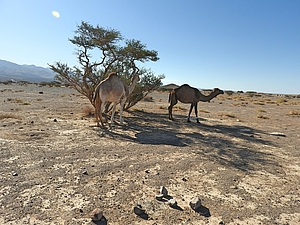
At lunch time, the drivers lit fire again and used a special local grill. It was a big metal drum with three levels, first rice, then onions and potatoes, pieces of spiced chicken on the top. A tasteful lunch was ready in an hour and was served under the date palms.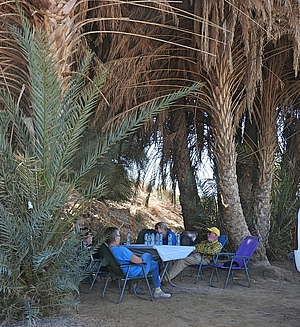
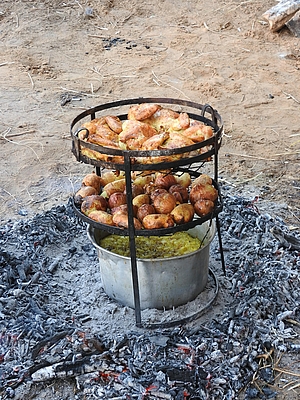
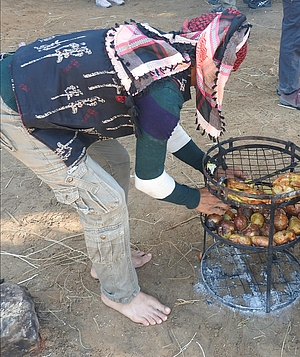
One of the drivers spoke good English and was ready to discuss the present life in Jordan. His words: „We want to be friends with everybody, Iraq, Syria, Israel, we have no time for war, we have to work.“
He explained that relationship with Israel is not on an equal level. A new border crossing between Israel and Jordan will be officially opened starting 1st January (he showed us the place in the distance) and Israelis will be allowed to come over to see Petra for one day without any formalities. Even by car, which is not allowed for Jordan population if they manage to get a complicated visa to Israel. However, the present security situation in Israel is not good, so that they do not want to go there anyway. We met on our way 6 black jeeps, supposedly already the Israelis coming for their one day visit to Petra. The driver did not comment on it too friendly – obviously after four wars between Israel and Arab countries since the end of the 2nd World War which caused many deaths on both sides, the wounds had not time to heal yet.
Our driver had also courage to raise some criticism towards his own government: „Our government is like a person with bad digestion, it is swallowing the food, but nothing is coming out. The government is only taking and giving nothing to the population. Even in the time of Corona, when governments of most countries tried to help their people to overcome hard times, Jordanian government gave nothing.“ However, he had not mentioned the king (maybe criticizing him could cause him problems).
In the evening we had a dinner with a man from Bedouin family, although dressed in a European way, in a big Bedouin tent. He spoke German about the life of his traditional society and its relations to Arabs. (Arab bread was made in front of a tent by a Bedouin lady on a traditional oven). Bedouins consider themselves to be the original population of Jordan. The word bedouin comes from the Arabic badawí, which means "desert dweller", and is traditionally contrasted with hadir, the term of sedentary people. Historically, the Bedouins engaged in the steppe in nomadic herding, agriculture and sometimes fishing since 6000 BCE. By about 850 BCE, they established a complex network of settlements and camps. The earliest Arab tribes emerged from Bedouins. Presently, Bedouins are muslims. The separation of sexes, girls and boys, starts already at school, marriages are arranged within the certain clan. When asked, why girls and boys have to be separated, who gave such an order, the answer was that nobody, it is simply cultural tradition. He even did not want to admit the influence of islam in this respect, he just repeated, it is a custom. In modern times many Bedouins settled down in the cities and work in standard jobs, however they feel often discriminated by the Arabs. Those who remained with the traditional way of life are divided to two groups: the eastern Bedouin are camel breeders and herders, while the western Bedouin herd sheep and goats. The division of the area has been made by the Desert Highway. Jordanian Bedouins are traditionally supporters of the monarchy, although recently they have expressed their dissatisfaction when they were facing increasing prices for the feed of the animals. They also took part in demonstrations of Arab Spring in 2011. 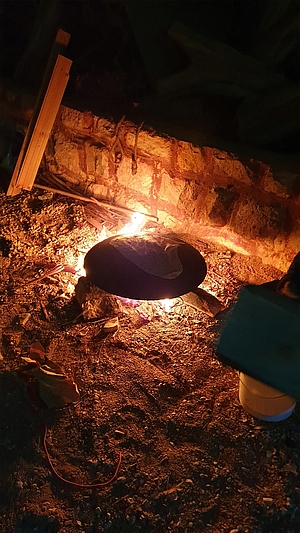
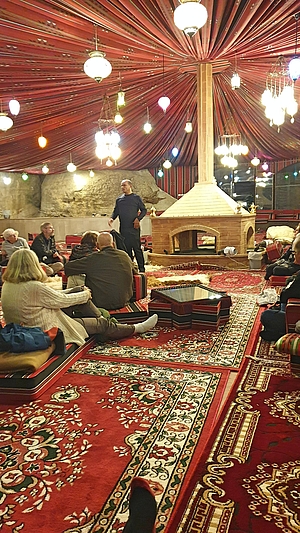
Day 7 – Little Petra, Neolithic village Bayda
Little Petra is smaller than Petra, but is just as impressive. It is also a Nabataen site with buildings carved into the walls of the sandstone canyons. It consists of three wider open areas connected by 40 meter long canyon. It is not so overrun by tourists which makes it more pleasant place. One of the most interesting sights is rock cut painted Biclinium, or dining place for two persons, with well preserved wall paintings.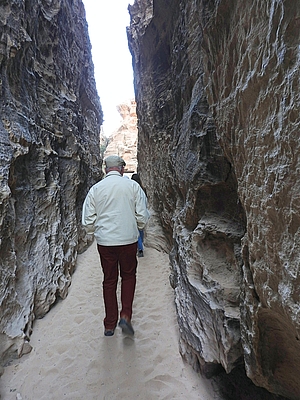
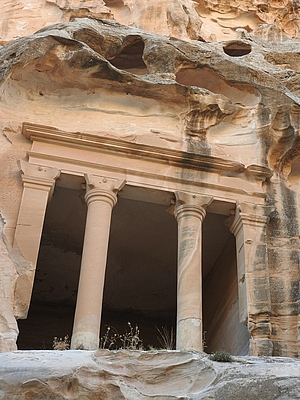
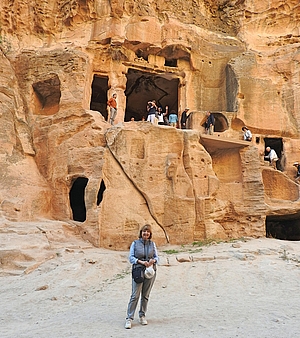
Nearby Little Petra there are excavations of Neolithic village Bayda. On the rocks we admired a plant which seemed to survive everything, but we could not find its name.
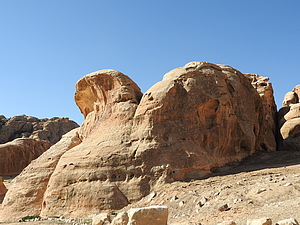
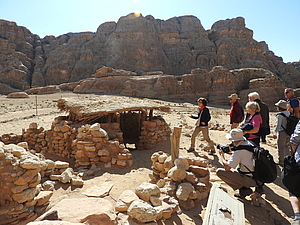
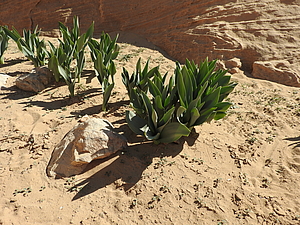
Day 8 - Aqaba
Aqaba is a resort with very nice beaches with crystal clear water, catering for the elite of the region. Major hotels as our Intercontinental have private beaches with perfect service, a day spent at the seaside did us really good. When you want to enter the sea, at the beginning you have to step over many pebbles, but later on is sand. We also made a walk around to see the main mosque and a small souk. 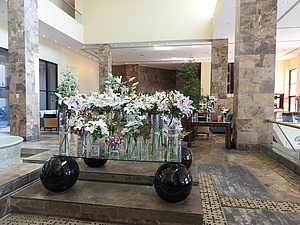
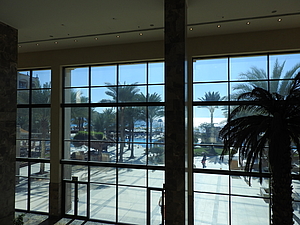
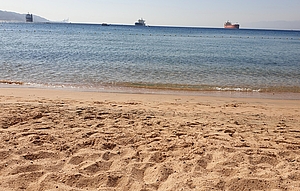
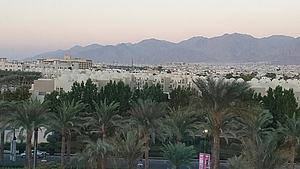
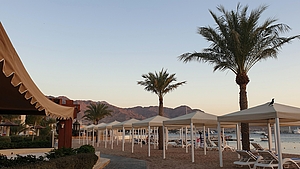
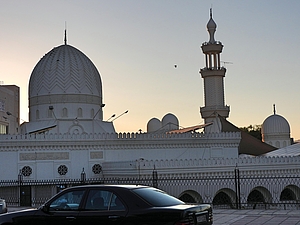
Day 9 - Wadi Rum
Our travel back from Aqaba to Amman started in the morning (280 km).
On the way we visited the famous Wadi Rum, Valley of the Moon, cut into the sandstone and granite rock. It became famous because of connection to the British officer T. E. Lawrence, called Lawrence of Arabia (movie from 1962). He played a major part in 1916 Arab Revolt, driven by long term ressentiment towards the Ottoman authorities and growing Arab nationalism. Lawrence of Arabia together with Faisal I., the king of Syria and Iraq, fostered unity between Sunni and Shiite Muslims and promoted pan-Arabism (see details in the history of Jordan at the end of this story). The cupolas in the picture below are an example of a modern environmentally friendly accommodation in the desert. 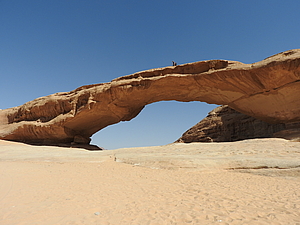
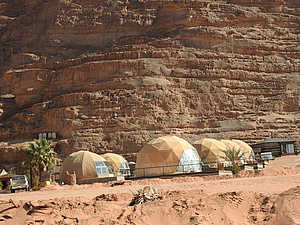
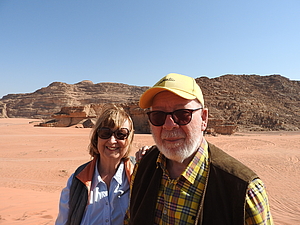
The Wadi Rum landscape continues attracting film makers, especially for the films situated on Mars – Red Planet, Mission to Mars (both made 2000), The Last Days on Mars (2013), The Martian (2015), etc.
It is also known for its unique collection of petroglyphs and inscriptions which illustrate the 12 000 years of human occupation in the Wadi Rum desert. Since prehistoric times, humans of different cultures have inhabited the Wadi Rum desert. Petroglyphs are images created by removing part of a rock’s surface by incising, pecking, carving, with something like a stone chisel. Inscriptions are characters. These illustrations of people show human figures holding bows and arrows, drawings of animals like camels, ibex, and horses. And alongside all these figures are symbols like lines and circles. Experts concluded that they are instructions and messages left by the people for one another. Some of them are about giving directions to find hidden springs. Altogether, these engravings provide an insight into the development of human thought. They show a pattern of pastoral, agricultural, and urban human activity. And they also tell more about the climatic change. From the mildly humid climate to the semi-arid environment of today. The numerous inscriptions found in Wadi Rum are in four different North-Arabian scripts, Thamudic, Nabatean, Islamic, and Arabic. They show the very early development of alphabetical writing among the societies in the peninsula. It was one of the reasons for UNESCO to put our desert on the World Heritage List.
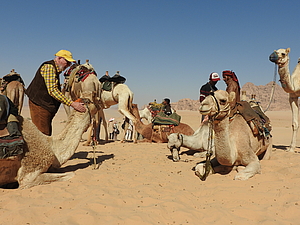
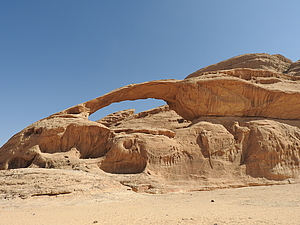
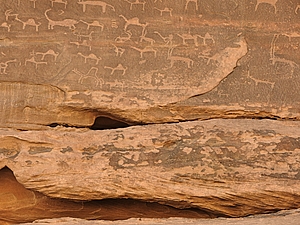
General observations:
Guides
We had two guides – a studied German archeologist Daniele from Tübingen and local guide Muhamed. He lived in Germany 20 years, returned to Jordan because his mother was ill and he as the only son he had to take care of her. His mother had died, later on his wife as well and he remained on his own for some time, as his children remained in Germany. However, 2 years ago he remarried and intends to live in Jordan till the end of his days. He was not ready to talk politics – „whatever happens, it is Allah´s will, Allah takes care of everything.“ When directly asked, he did not see much difference between the deceased king Hussein and his son Abdullah II., "maybe Hussein was stronger personality, which was good." 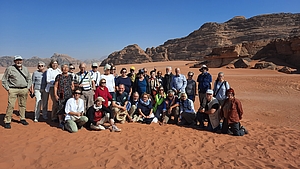
Infrastructure, electricity, water
Most of the roads in Jordan are good. When travelling around we saw on our way some groups of wind mills and solar panels, but also many tankers bringing oil to Jordan. Jordan has some oil reserves but the production is very low, meaning that it has to import most of its oil. But the country has enough electricity – everything in the towns is well lit, nobody seems to be bothered about saving electricity. However, i tis quite different with water. Jordan is one of the most water scarce countries in the world. When we were going from Aqaba to the north, we could first see amazing rock structures not only around Petra but all around the roads. However, later on the landscape changes to a flat desert which looks absolutely desolate. More to the north the landscape becomes greener, especially south and north of Amman. The reason of water shortage are rising temperatures, reduced rainfall, limited vegetation, and rapidly increasing population. Efforts to restore once fertile land have been so far in vain.
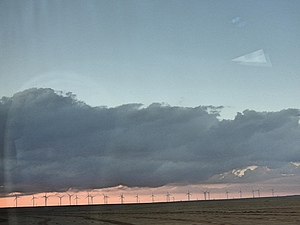
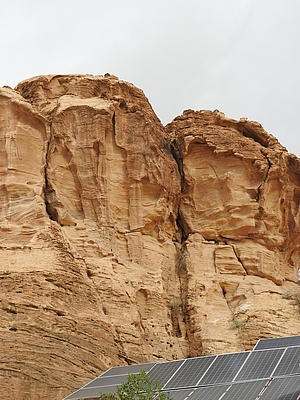
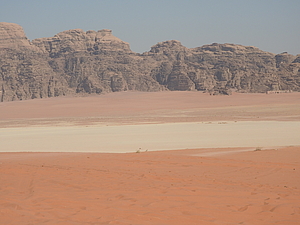
It is sad to realize that the countries of the so called „Fertile Crescent“ (region in the Middle East spanning modern day Iraq, Syria, Lebanon, Israel, Palestine and Jordan, together with the northern region of Kuwait, southeastern region of Turkey and the western portion of Iran, maybe also Cyprus and northern Egypt) which were the very first region where settled farming emerged as people started the process of clearance and modification of natural vegetation to grow newly domesticated plants as crops, regions which used to have plentiful water or watering systems have presently changed in many parts to a hostile desert.
Smoking, services
Smoking in many restaurants and cafés is permitted, but many Jordanians prefer water pipe. When I went to hairdresser, they placed automatically in front of me ash tray and bottle of water. Washing and blow drying my hair was one of the cheapest done recently: 10 Jordanian dinars, which is 13 EUR (in Germany I pay at the moment 28 EUR, in Prague 11 EUR, in Spain 25 EUR, I do not know how they changed the prices in India yet).
George went to the barber´s to have his beard cut and let himself to be seduced to complete treatment, which he normally never does. It included cleaning the skin, various masks, massage and in the end also shaving J. He should not have been surprised when he paid 40 Jordanian dinars.
Industry, natural resources
The main industry in Jordan is concentrated in the north of the country, whilst south mostly depends on tourism (Red Sea, Petra). There is a general feeling that Jordan is poor country because of the lack of natural resources. However, the truth is that mineral resources of the country include large deposits of phosphates, potash, limestone, and marble. There are also unexploited deposits of copper, uranium and shale oil, which if exploited could make this poor country rich. But of course, it would need first a huge investment. In Saudi Arabia, oil is very near the surface, in Jordan it would be necessary to drill deep.
Business
We stayed in Amman three days longer to be able to meet our potential business partners. It is a big company with many diversified businesses but their new division dedicates itself to production of the material which can replace cement in concrete. Similar to the use of our Pozzocrete, only their product is made by grinding together basalt and granite, ours is fly ash originated by burning coal in thermal power stations.
We were invited to a Arab restaurant on the hill and offered all variety of Arab starters and plentiful grilled meets and kebabs, also bread different of the typical Arab flat bread which looked and tasted as Indian naan bread. There was no alcohol available in the restaurant, but both our business partners assured us that the Jordan people must have one of the largest consumes of alcohol in the world, in spite of some restrictions. Besides the business discussions we have learnt a lot about life and opinions of Jordanian people.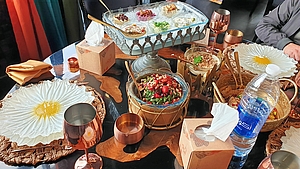
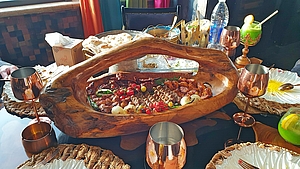
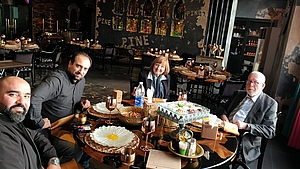
"Everything in Jordan is very expensive, mostly because of the governmental taxes – middle class Toyota costs 40 000 dinars. The teacher would earn around 500 dinar, the minimum wage is 250 dinar monthly. Our friends laughed when they said that the only cheap thing in Jordan are cigarettes. 90 % population smokes, cigarretes, water pipes or both. Smoking in restaurant is permitted. Cannabis is being produced in huge fields in the south, most of it goes to Israel. Jordan is considered a transit country for cannabis and other drugs."
Sulaiman´s family came to Jordan after the first war with Israel 1947 – they were Palestinians, and had to leave everything behind. Omar´s family comes from Jordan. When I asked if arranged marriages are prevailing in Jordan as they do in India, the answer was that the inhabitants of towns usually select the partners themselves, as they both did. Of course, situation would be different among Beduins or in the country.
Their views regarding economy: "There is no real construction boom in Jordan, besides housing projects there is not much happening. The biggest projects are in neighboring Saudi Arabia. E. g., not far from the border, the Saudis want to build completely new town based on the latest technologies – similar to Dubai. Their company also exports some of their products to Iraq, but the problem is a horrible corruption, if they sell something for 200 dinar, before it reaches the final user in Iraq, it costs 400 dinar. The relations with Israel are not en par. It is possible for Jordanians to apply for a visa, but the entry is in most cases refused to younger people. People over 60 have more chances of getting the visa. On the other hand, the Israelis are allowed to enter Jordan for business and pleasure. Fortunately things seem to improve a little, economic cooperation has just started on the basis of Free Economic Zone – Israel promised to invest to water desalination and Jordan will supply electricity to Israel."
Generally the opinions of both our business friends, although university educated, were very similar to the attitudes of the drivers who took us to the desert.
"The government should try to achieve understanding with all the nations, especially with its neighbors, but also with the superpowers. Sadam Hussein of Iraq was talking too much and thought that he could challenge USA which became fatal for him and for his country. No country should dare to challenge USA. It also does not make any sense to dream about lost territories, either in a history or recently, like West Bank of river Jordan which was first acquired and then lost by Jordan to Israel. Politicians should be realistic and see what is possible to achieve and with the aim to prevent any further wars. Of course, for that compromises are necessary, but very often parties in war have not enough courage for that. Therefore Jordan remains neutral also in the conflict between Russia and Ukraine – they take sides with none of them."
After 14 days, we returned to Germany on a flight from Frankfurt to Amman, which took four and a half hours and was just like the flight to Jordan without any problems. A visa is required for Jordan, but it is possible to buy it on arrival. Although we were informed that we had to register in advance through the Jordanian Ministry of Interior website, no one checked the confirmation, just like no one was interested in the Covid vaccination certificate. Masks are not obligatory in Jordan, nor were they mandatory on the Lufthansa plane.
History
History of Jordan is so complicated that I was hesitant if I should not make here only a short summary. On the other hand I know that some of my friends are interested in history in details and a more detailed description is also good for refreshing my memory.
Which means, if you are interested mainly in the first hand experience and photos, that´s what you have just read above. The rest is a compilation of history of Jordan including the contemporary events from various internet sources.
Jordan is rich in many Paleolithic (Stone Age) remains, upto 20 000 years old.
On the archeological site in the village Ain Ghazal near Amman there was discovered a number of large scale lime plaster and reed statues (15 statues and 15 busts), which are among the earliest large scale representations of the human form dating from pre-pottery Neolithic culture centered in upper Mesopotamia and the Levant between 8800 to 6500 BC. Some of them are to be seen in Amman museum.
Fortified towns and urban centers first emerged in the southern Levant early on in the Bronze Age (3600–1200 BC). Wadi Feynan became a regional centre for copper extraction for production of bronze. Villages in Transjordan expanded in areas with reliable water-resources and agricultural land. Later on Egyptians expanded towards the Levant and controlled both banks of the Jordan river.
During the Iron Age (1200-332 BC) after the withdrawal of the Egyptionas, Transjordan was home to the tribal Kingdoms of Ammon, Edom and Moab. The people of these kingdoms spoke Semitic languages.
The northwestern region of the Transjordan, known then as Gilead, was settled by the Israelites. The tribal kingdoms continually clashed with the neighboring Hebrew Kingdoms of Israel and Judah, centered west of the Jordan River. It is recorded on the Mesha Stele, also called Moabite Stone, erected by the Moabite king Mesha in 840 BC, where he is praising himself for his building projects and commemorates his glory and victory against the Israelites.
The stele, whose story parallels, with some differences, an episode in the Bible's Books of Kings, provides invaluable information on the Moabite language and the relations between Moab and Israel in the 9th Century BCE. It is the most extensive inscription ever recovered that refers to the kingdom of Israel and also to the Israelite god Yahweh (Jehowa).
A "squeeze" (a papier-maché impression) had been obtained by a local Arab on behalf of Charles Simon Clermont-Ganneau, an archeologists based in the French consulate in Jerusalem. The next year, in 1899 the stele was smashed into several fragments by Bani Hamida Nomad tribe in an opposition against Ottoman authorities who had pressured the Bedouins to hand over the stele so that they could give it to Germany. The Nomads tried to destroy it by lighting a fire under it and then pouring cold water over it.
Clermont-Ganneau later managed to acquire the fragments and piece most of them together thanks to the impression made before the stele's destruction. It is exhibited in Louvre, we have seen its copy in Archeological museum on the Mount Nebo.
In the 8th century BC the kingdoms of Ammon, Edom & Moab were subjugated by the Neo-Assyrian Empire, but were allowed to maintain some degree of independence. Babylonians took over the Assyrians Empire after its disintegration in 627 BC. The kingdoms were reduced to vassals, a status they retained also under the Persian and Hellenic Empires. (the hellenistic culture was introduced to the Middle East with Alexander the Great´s conquest of the Persian Empire in 332 BC.)
After Alexander's death in 323 BC the Transjordan area was disputed between the Ptolemies based in Egypt and Sleucids based in Syria. The Nabataeans, nomadic Arabs based south of Edom, exploited the struggle between the two Greek powers and established an independent kingdom in 169 BC. The Nabataean Kingdom controlled much of the trade routes of the region, stretching south along the Red Sea and Hejaz desert up to Damascus. Petra, originally Nabatea´s barren capital started to florish in the 1st century AD, driven by its extensive water irrigation systems and agriculture. The Nabataeans were also talented stone carvers, their most elaborate structure is Al-Khazneh, which is believed to be the mausoleum of the Arab Nabataean King Aretas IV.
The last Nabatean monarch, Rabbel II, struck a deal with the Romans that as long as they did not attack during his lifetime, they would be allowed to move in after he died. Upon his death in 106 CE, the Roman Emperor Trajan annexed Nabatean Kingdom unopposed and renamed it Arabia Petrea. Trajan also rebuilt the King´s Highway which became known as Via Traiana Nova. It was a trade route connecting Africa with Mesopotamia, running from Egypt across Sinai Peninsula to Aqaba, turning northward across Transjordan to Damascus and the Euphrates River. During the Roman rule around 63 BC, kingdoms of Ammon, Edom and Moab had lost their distinct identities, and were assimilated into the Roman culture. Roman rule lasted four centuries.
In 324 AD the Roman Empire split to Western and Eastern Empire, later known as the Byzantine Empire, which continued to control the region until 636 AD. The Emperor Constatine the Great converted to Christianity and Christianity had become legal within the empire in 313 AD. Transjordan prospered during the Byzantine era and Christian churches were built everywhere. The Aqaba Church in Ayla is considered to be the world´s first purpose built Christian church. The site Umm ar-Rasas in southern Amman contains at least 16 Byzantine churches, mosaics and stylite tower, the soaring structure served as a platform for Christian ascetics living in isolation at the top as well as an altar for a call to prayer. Meanwhile, Petra´s importance declined, eventually being abandoned after two earthquakes.
The Byzantines were defeated by the Muslims in 636 AD at the decisive Battle of Yarmouk just north of Transjordan. The area was governed by various Caliphates, last one Fatimid Caliphate (969 – 1070). After the First Crusade 1099 there was established Crusader Kingdom of Jerusalem which lasted nearly 100 years until 1187 when crusaders lost to Saladin, the founder of the Ayyubid Dynasty (reigning in Egypt1187-1260). 2nd Kingdom of Jerusalem was reestablished in Acre 1192 after the Third Crusade and lasted until city´s destruction in 1291. The vast majority of the crusaders who established and settled the Kingdom of Jerusalem came from France. They brought the French language to the Levant, thus making old French lingua franca of the Crusader states. Several of the Ayyubid castles were used and expanded by the Mamluks during their reign between 1250–1517.
Mamluks, also spelled Mamelukes, were slave soldiers, usually non-Muslim, members of one of the armies of slaves established during the Abbasid era that later won political control of several Muslim states including the territory of today´s Egypt, Syria and Transjordania. Under the Ayyubid sultanate, Mamluk generals used their power to establish a dynasty that ruled Egypt and Syria from 1250 to 1517.
In 1516, the Ottoman Caliphate conquered Mamluk territory. However, Transjordan was of marginal importance to the Ottoman authorities. As a result, more Arab Bedouin tribes moved into Transjordan during the first three centuries of Ottoman rule. With the absence of a meaningful Ottoman authority, Transjordan slid into a state of anarchy that continued until 19th century. Only after Ibrahim Pasha´s campaign (he was the son of governor of Egypt and in 1833 first rooted out the Wahabis and then established his rule over the Levant) the Ottoman Empire tried to solidify its presence in the region. The construction of the Hejaz Railway stretching across the length of Transjordan and linking Mecca with Istanbul helped the population economically, as Transjordan became a stopover for pilgrims. However, increasing policies of turkification and centralization adopted by the Ottoman Empire disenchanted the Arabs of the Levant.
Four centuries of stagnation during Ottoman rule came to an end during World War I by 1916 Arab Revolt, driven by long term ressentiment towards the Ottoman authorities and growing Arab nationalism (important role of T. E. Lawrence – Lawrence of Arabia - together with Faisal I. the king of Syria and Iraq, who fostered unity between Sunni and Shiite Muslims and promoted pan-Arabism with the aim of creating an Arab state that would include Iraq, Syria and the rest of so called Fertile Crescent (region in the Middle East spanning modern day Iraq, Syria, Lebanon, Israel, Palestine and Jordan, together with the northern region of Kuwait, southeastern region of Turkey and the western portion of Iran, maybe also Cyprus and northern Egypt). The Fertile Crescent is the very first region where settled farming emerged as people started the process of clearance and modification of natural vegetation to grow newly domesticated plants as crops. As a result, early human civilizations such as Sumer in Mesopotamia flourished. Technological advances in the region include the use of irrigation, of writing, the wheel, and glass, most emerging first in Mesopotamia. Obviously the countries of the so called „Fertile Crescent“ could develop because they had enough water which could be used also for irrigation, the area was green. Presently the big parts of the area have changed to a desert.
Arab aspirations failed to gain international recognition, due mainly to the secret 1916 Sykes-Picot Agreement between the UK and France, with assent from the Russian Empire and Kingdom of Italy, which defined their mutually agreed spheres of influence in eventual partition of the Ottoman Empire. Another obstacle was Balfour Declaration of 1917 which promised Palestine to Jews. This was seen by the Hashemites and the Arabs as a betrayal of their previous agreements with the British who originally stated their willingness to recognize the independence of a unified Arab state stretching from Aleppo to Aden under the rule of the Hashemites.
The nascent Hashemite Kingdom over Greater Syria was forced to surrender to French troops on 24 July 1920 during the Battle of Maysalun. However, the French occupied only the northern part of the Syrian Kingdom. The Emirate Transjordan became in the years 1921 – 1946 British Protectorate, as a part of the British mandate Palestina, given to Britain by League of Nations at Paris Peace Conference 1919.
Only the Treaty of London, signed by the British Government and the Emir of Transjordan on 22th March 1946, recognized the independence of Transjordan upon ratification by both countries' parliaments. The King Abdulah I. was reading to the nation the Declaration of Independence of the Hashemite Kingdom of Transjordan in May 1946, the name was later on shortened to Hashemite Kingdom of Jordan (in 1949).
In 1948 Jordan intervened in Palestine together with many other Arab states in Arab-Israeli war. Following the war, Jordan controlled the West Bank and in 1950 formally annexed these territories. In response some Arab countries demanded Jordan´s expulsion from the Arab League, however later on the Arab League declared that the annexation was a temporary measure and that Jordan was holding this territory as a „trustee“.
King Abdullah I was assassinated in 1951 by Palestinian militant, because of the rumours that he intended to sign a peace treaty with Israel. He was succeeded by his son Tallal, who abdicated after some months due to illness in favour of his eldest son Hussein in 1953. Hussein was just 17 years old. He was with a very difficult task. The 1950s were a period of political upheaval, as Nasserism (named after Egyptian president Gamál Nasser) and Pan-Arabism swept the Arab World.
Jordan signed a military pact with Egypt just some days before Israel launched a strike on Egypt to begin the Six-Day War in 1967, where Jordan and Syria joined the war. The Arab states were defeated and Jordan lost control of the West Benk to Israel. The War of Attrition with Israel followed, which included the 1968 battle of Karameh, in which the combined Jordanian and Palestine Liberation Organization armed forces repelled an Israeli attack.
The forth Arab-Israeli war (Yom Kiphur War) in which Jordan did not participate directly started 1973. It became more and more clear that there will never be real final winners and losers in these wars. This recognition both on Israel and on Egypt side paved the way for the beginning of peace process. David Camp Accords were signed between the two states 1978. Israel returned the entire Sinai Peninsula to Egypt and subsequently in 1979 Peace Treaty Egypt, as the first Arab country, recognized Israel as a legitimate state.
At the Rabat summit conference in 1974 Jordan agreed along with the rest of the Arab League that PLO was the sole legitimate representative of the Palestinian people and later on, in 1988, Jordan renounced its claims to the West Bank.
Several factors gave rise to increased adherence to Islamic practices of population during the 1970s and 1980s, in response to the economic recession and to the failure of nationalist politics to solve regional problems. In this context, Islam was an idiom for expressing social discontent. In Jordan, opposition politics had long been forbidden, and since the 1950s the Muslim Brotherhood had been the only legal political party. These factors were exacerbated by King Hussein´s public support for the Shah of Iran in his confrontation with Ayatollah Khomeini and the forces of opposition, by Jordan´s continued relations with Egypt in the wake of the 1979 Treaty of Peace Between Egypt and Israel, and by the king´s support for Iraq in Iran-Iraq war (1980-88).
Although Islamic opposition politics never became as widespread in Jordan as in Iran or Egypt, they were pervasive enough for the regime to act swiftly to bring them under its supervision. By the close of the 1970s and throughout the 1980s, government-controlled television regularly showed the king and his brother Hasan attending Friday prayers.The media granted more time to religious programs and broadcasts. Aware that the Islamic movement might become a vehicle for expressing opposition to the regime and its policies, and in a move to repair relations with Syria, in the mid-1980s the government began to promote a moderate form of Islam, denouncing fanatical and intolerant forms.
Jordan signed the Peace Treaty with Israel in 1994. Prime Minister Rabin and Prime Minister Abdelsalam al-Majali signed the treaty and the President of Israel Ezer Weizman shook hands with King Hussein. The existence of the Treaty was threatened in 1997, when Israeli agents, using Canadian passports, in retribution for bombing, entered Jordan and poisoned Khaled Meshal, a senior Hamas leader living in Jordan. Bowing to intense international pressure, Israel provided an antidote to the poison and released dozens of political prisoners after King Hussein threatened to revoke the Peace Treaty.
King Hussein, who ruled the country nearly 50 years, died in 1999 and his son Abdulah II ascended the throne.
He has tried to modernize the country by some economic and political reforms. Al-Qaeda launched coordinated explosions in 3 hotel lobbies in Amman on 9th November 2005, resulting in 60 deaths and 115 injured civilians as Islamic extremists view Jordan and Abdullah with contempt for the peace treaty signed with Israel and its relationship with the West. No major terrorist attacks have occurred since (with the exception of a smaller attack at the Castle Karak in 2014). Jordan´s internal security has been dramatically improved.
To counter the wave of The Arab Spring in 2011, Abdullah replaced his prime minister and introduced reforms of Constitution and laws governing public freedoms and elections. Jordan was left largely unscathed from any violence that swept the region despite an influx of 1.4 million Syrian refugees.
However, the country is far from the liberal democratic state, especially regarding the freedom of press. An example of it is the case of Prince Hamzah bin Hussein (the fourth son of King Hussein, and the first one by his American born forth wife Queen Noor), where the local press remained simply silent. Hamzah was named crown prince of Jordan in 1999 and was a favourite of King Hussein, who often described him in public as the "delight of my eye". However, he was seen as too young and inexperienced to be named successor at the time of King Hussein's death. Instead, his older half-brother, Abdullah, ascended the throne and stripped Hamzah of the title of Crown prince in 2004. The move was seen as a blow to his mother Queen Noor, who had hoped to see her eldest son become king.
Hamzah´s mother Noor is the longest-standing member of the Board of Commissioners of the International Commission on Missing Persons. As of 2011, she is president of the United World Colleges movement and an advocate of the anti-nuclear weapons proliferation campaign Global Zero.
On 4 April 2021, Hamzah was placed under house arrest after accusing the country's leaders of corruption, incompetence and harassment. BBC published a video of Hamzah in which he reported that he has been placed under house arrest as a part of a crackdown on critical voices in Jordan. There were rumors that he was a part of a "malicious plot" to destabilize the kingdom.
He renounced his prince title in April 2022 and a month earlier, he had reportedly apologized to the King in a letter, wishing to "turn the page on this chapter in our country's and our family's history". However, in May 2022, the King formally announced that Hamzah had been put under house arrest and his possibilities of communication and movements were limited due to his "erratic behavior and aspirations". Nobody said a word about all this during our stay in Jordan.
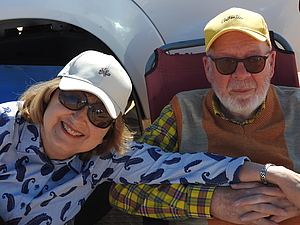
Good bye, Jordan


